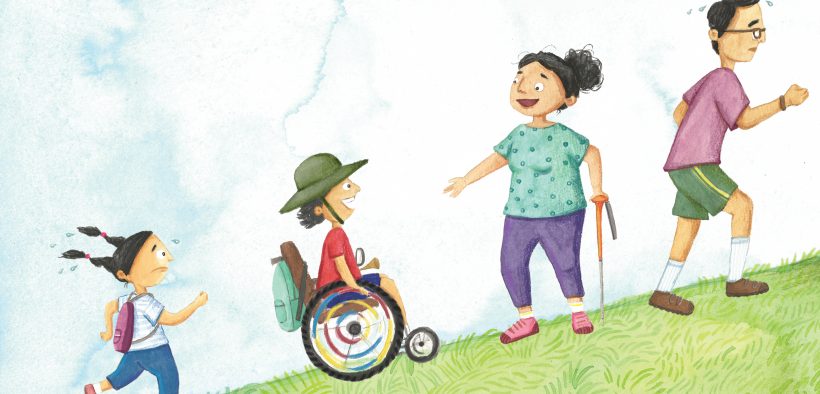Salil Chaturvedi on writing My Brother’s Wheeeeelchair

Here’s a peek into our one-on-one with Salil Chaturvedi, author of ‘My Brother’s Wheeeelchair‘ – where he celebrates difference and discusses the need for awareness and visibility of disability in the public sphere.
Pratham Books: Does ‘My Brother’s Wheeeeelchair’ draw inspiration from real people/memories in your life? If yes, please do tell us more!
Salil Chaturvedi: Durva, the narrator of the story, is based on a seven-year-old girl I encountered at a friend’s house in a party. She was fascinated by my wheelchair and couldn’t take her eyes off me. It was such a spectacle for her. Finally, she mustered the courage to approach me and as I introduced her to the workings of the wheelchair, she bowled me over by asking quite innocently, ‘Do you also go to sleep with it?’ That image of sleeping with the chair attached to me in bed has stayed, and always generates laughter when I think about it.
Then the bit about the boy carrying his sister over puddles comes from a real-life incident where a friend hopped on to my chair to avoid getting his shoes wet! And at the end of the story, all the friend’s wanting to ride the wheelchair comes from the countless requests I receive from children to ride my chair. In fact, a niece of mine, when she was younger, would wait for me to rest so that she could sneak away with the wheelchair and ride it around the house.
Pratham Books: What was your experience of seeing your words illustrated in a picture book?
Salil Chaturvedi: Tanvi Bhat has created such visual delight! It was a collaborative effort and my role was limited to pointing out aspects of the wheelchair. One of my favourite things in the book are the girl’s pigtails! So, that’s what visual artists end up doing…introducing these unexpected charms. Also, the intimacy between the brother and sister has been beautifully illustrated by Tanvi. I don’t think the original writing captured that quite as well as the illustrations depict. She has infused the story with fun.

Illustration by Tanvi Bhat for ‘My Brother’s Wheeeeelchair’
Pratham Books: We would love to know your thoughts about the importance of representation of differently-abled persons in children’s literature.
Salil Chaturvedi: It’s not just children’s literature, we need to see more disabled children in schools! It’s only when a classroom has someone in a wheelchair or a blind child, or a speech-and-hearing child that integration can happen in the imagination. Till then it’s all experienced as tales of the ‘other’. Years ago, when my friend, Aniruddha Sen Gupta, was creating The Fundoo 4 series of books (four friends solving mysteries) – and during a brainstorm, we decided to have one of the children as a speech-and-hearing impaired child. That allowed him to introduce a secret mode of communication between the friends because they could all communicate in sign language, which is such a perfect thing for four young adventurers who are taking on villains. It was an unexpected outcome from the desire to introduce a disabled child into the story. It’s such partnerships in real life that need to happen, and a physically accessible society is a big part of it.
Pratham Books: India’s got a long way to go to be ‘accessible’. how can people help spread awareness
Salil Chaturvedi: As you perhaps know, disabled people are often called the ‘Invisible Minority’ because they are just not seen enough. It’s a Catch-22 situation. You don’t see too many disabled persons on the streets or in offices, etc., because the built environment is not accessible. They are not accessible because there aren’t too many disabled persons out there. Of course, things have changed a lot in the past decades and are continuing to do so. But still, there is a lot of stigma attached to disability. ‘My Brother’s Wheeeeelchair’ is also an attempt to show that life is not all bad for a disabled child. There are oodles of joy to be experienced, too. Disabled people are Olympians, they are ministers, mountaineers, musicians, physicists, doctors, artists, what have you. So, writers, I think, can play a powerful role in spreading awareness by bringing more disabled characters into stories—novels, films, picture books, even advertisements—where they are portrayed NOT in a ‘special’ way but as part of normal situations. We have to make disability visible and normalise it. I think the two are connected. I mean our limbs are not divine as the government will have you believe with all the ‘divyang’ nonsense.
Disabled persons themselves also have to go out a lot more and make a fuss. It’s funny how many people I have to show the workings of my car—at petrol stations, in market places, at toll plazas—because they have never seen a disabled person drive a car. The other question that we (my wife Monika, and I) get asked a lot is about when the disability happened because people find it difficult to accept that someone would want to marry a disabled person. So, just being out there is spreading awareness! And books are a great way of spreading the light.
